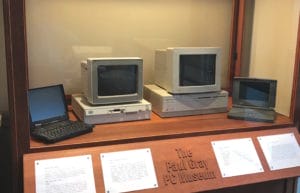Paul Gray PC Museum Relaunches; Chatterjee on motivating sick patients with tech

Paul Gray saw the future.
Back in the 1980s, long before other universities decided to create an Information Science program, Gray was already founding one at CGU.
“Paul was a real pioneer. He was amazing,” said President Len Jessup, who studied management information systems as a graduate student and frequently met Gray at information systems conferences. “And this exhibit is a great tribute to his leadership in the field.”
Jessup joined a large group of Gray’s former colleagues, friends, and admirers in late September to celebrate the re-launch of the Paul Gray Personal Computer Museum. Also speaking at the event were Cultural Studies alumna Kiera Peacock (who created the new exhibit), History Department Chair Josh Goode, CISAT Director Lorne Olfman, and Terri Childs, Gray’s daughter.
For many years, specimens from Gray’s collection of early computers have been a familiar sight in the lobby of the university’s Academic Computing Building. But Peacock, who also studied Museum Studies, decided to take her passion for museum work and apply it to refreshing the exhibit—and giving greater attention to the work of a man who touched so many lives on campus and off.
“The work that I did for [a transdisciplinary course about technology and science museums] developed into a masters thesis project and eventually led to what you see in the museum today,” said Peacock, who is also the museum’s executive director.
Six large exhibit cases, located on the first and second floors of the ACB lobby, greet visitors with holy relics from the dawn of the personal computing era.
There you’ll find the do-it-yourself Altair 8800 (1974), Tandy/Radioshack’s TRS-80 (1977), and 1985’s Commodore Amiga along with the IBM Thinkpad (1994), the ground-breaking Apple II (1977) — the first personal computer with color graphics — and many others.

Gray’s daughter expressed her thanks to the university for its support of her father and her gratitude for the exhibit created by Peacock.
“I never met Dr. Gray, but I think we would have gotten along,” Peacock said. “I recently heard an anecdote about him, that he could be seen speeding around campus, hunched over in his haste to get to work. I love that, it makes me feel a sort of kinship with this brilliant information scientist knowing he too had a compulsive need to make progress on a project.”
***
THE POWER OF PERSUASION: In a recent piece published at The Conversation, CISAT’s Samir Chatterjee makes the case for using what is known as “persuasive technology” to help people manage their chronic illnesses and improve their behavior at the same time.

It was a chance phone call, in March 2014, that started “a long and fruitful collaboration” between Chatterjee’s IDEA Lab and Loma Linda University SACHS Heart Clinic.
Working with Loma Linda “was a key step in helping my lab uncover the potential and pitfalls of using digital technologies to improve chronic disease management,” writes Chatterjee, who is the Fletcher Jones Chair of Technology Design & Management.
How did Chatterjee and his Loma Linda counterparts help heart failure patients better handle their circumstances?
Chatterjee explains how external motivators—like a MyHeart app, a Bluetooth-enabled weight scale, blood glucose meter, and other equipment—provide patients with a greater sense of control and empowerment with their situations.
Read more of Chatterjee’s article.